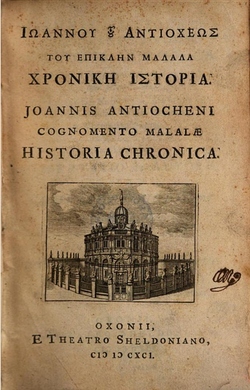
John Malalas
John Malalas (/ˈmælələs/; Ancient Greek: Ἰωάννης Μαλάλας, romanized: Iōánnēs Malálas; c. 491 – 578) was a Byzantine chronicler from Antioch.

Life
Of Syrian descent,[1] Malalas was a native speaker of Syriac who learned how to write in Greek later in his life.[2] The name Malalas probably derived from the Syriac word ܡܰܠܳܠܰܐ malolo 'rhetor, orator'; it is first applied to him by John of Damascus. The alternative form Malelas is later, first appearing in Constantine VII.[3]

Malalas was educated in Antioch, and probably was a jurist there, but moved to Constantinople at some point in Justinian I's reign (perhaps after the Persian sack of Antioch in 540[4]); all we know of his travels from his own hand are visits to Thessalonica and Paneas.[5]

Writing

He wrote a Chronographia (Χρονογραφία) in 18 books, the beginning and the end of which are lost. In its present state it begins with the mythical history of Egypt and ends with the expedition to Roman Africa under the tribune Marcianus, Justinian's nephew,[6] in 563 (his editor Thurn believing it originally to end with Justinian's death[7]); it is focused largely on Antioch and (in the later books) Constantinople. Except for the history of Justinian and his immediate predecessors, it possesses little historical value;[6] the author, "relying on Eusebius of Caesarea and other compilers, confidently strung together myths, biblical stories, and real history."[8] The eighteenth book, dealing with Justinian's reign, is well acquainted with, and colored by, official propaganda. The writer is a supporter of Church and State, an upholder of monarchical principles. However, the theory identifying him with the patriarch John Scholasticus is almost certainly incorrect.[9]

Malalas cites many sources, including the lost or fragmentary works of Brunichius, Charax of Pergamum, Domninus, Eustathius of Epiphania, Eutropius, Eutychianus, Nestorianus, Philostratus, Priscus, Sisyphus of Kos and Timotheus.[10]

The work is important as the first surviving example of a chronicle written not for the learned but for the instruction of the monks and the common people,[6] and its language shows a compromise with the spoken language of the day, although "it is still very much a written style. In particular, he employs technical terminology and bureaucratic clichés incessantly, and, in a period of transition from Latin to Greek governmental terminology, still uses the Latin loanwords alongside their Greek replacements ... The overall impression created by Malálas' style is one of simplicity, reflecting a desire for the straightforward communication of information in the written language of everyday business as it had evolved under the influence of spoken Greek."[11]

It obtained great popularity, and was used by various writers until the ninth century; it was translated into Old Bulgarian probably in the tenth century, and parts of it were used for the Primary Chronicle.[12] It is preserved in an abridged form in a single manuscript now at Oxford[6] (Baroccianus 182) as well as in various fragments. A medieval translation in Georgian also exists.[13]

See also
References
- ^ "John Malalas | Byzantine chronicler". Encyclopedia Britannica. Retrieved 2021-01-25.
- ^ Lapidge, Michael (1996). Anglo-Latin Literature, Vol.1, 600-899. Bloomsbury Publishing. p. 98. ISBN 978-1-4411-0105-1.
- ^ Thurn, Ioannis Malalae Chronographia, p. 1.
- ^ Geoffrey Horrocks, Greek: A History of the Language and its Speakers (Longman Linguistics Library, 1997: ISBN 0-582-30709-0), p. 180.
- ^ Thurn, Ioannis Malalae Chronographia, p. 1.
- ^ a b c d One or more of the preceding sentences incorporates text from a publication now in the public domain: Chisholm, Hugh, ed. (1911). "Malalas, John". . Vol. 17 (11th ed.). Cambridge University Press. p. 461.
- ^ Thurn, Ioannis Malalae Chronographia, p. 2.
- ^ Warren Treadgold, A History of Byzantine State and Society (Stanford University Press, 1997: ISBN 0-8047-2421-0), p. 267.
- ^ Thurn, Ioannis Malalae Chronographia, p. 2.
- ^ Elizabeth Jeffreys, "Malalas' Sources", in Elizabeth Jeffreys, Brian Croke and Roger Scott (eds.), Studies in John Malalas (Brill, 1990), p. 196.
- ^ Horrocks, Greek, pp. 179-81, q.v. for details of lexical and syntactic usage; see also pp. 181-82 for a passage of Malalas with interlinear translation and transcription showing how Horrocks believes it would have sounded in the spoken Greek of the day.
- ^ Oleg Tvorogov, Хроника Иоанна Малалы Archived 2009-05-17 at the Wayback Machine.
- ^ Baldwin, Barry (1991). "Malalas, John". In Kazhdan, Alexander (ed.). The Oxford Dictionary of Byzantium. Oxford and New York: Oxford University Press. p. 1275. ISBN 0-19-504652-8.
Modern editions
- Text
- Johannes Thurn (ed.) 2000, Ioannis Malalae Chronographia, Corpus Fontium Historiae Byzantinae (CFHB) 35 (Berlin, New York: Walter de Gruyter) ISBN 3-11-008800-2
- Translation
- Elizabeth Jeffreys, Michael Jeffreys, Roger Scott et al. 1986, The Chronicle of John Malalas: A Translation, Byzantina Australiensia 4 (Melbourne: Australian Association for Byzantine Studies) ISBN 0-9593626-2-2
- Downey, G., ed. (1940). Chronicle of John Malalas, books VIII—XVIII. University of Chicago Press.
Further reading
- E. Jeffreys, B. Croke, and R. Scott (eds.), Studies in John Malalas (Sydney: Australian Association for Byzantine Studies, 1990) (Byzantina Australiensia, 6), pp. 1–25.
- David Woods, "Malalas, Constantius, and a Church-inscription from Antioch," Vigiliae Christianae, 59,1 (2005), pp. 54–62.
- J. H. W. G. Liebeschuetz, "Malalas on Antioch," in Idem, Decline and Change in Late Antiquity: Religion, Barbarians and their Historiography (Aldershot, Ashgate, 2006) (Variorum Collected Studies).
External links
- Chronicle of John Malalas (full, translated)
- Translation of the 8th book of Malalas' Chronographia
- Greek Opera Omnia by Migne Patrologia Graeca with analytical indexes
- Catholic Encyclopedia (1910 ed.), John Malalas"
- Malalas, Chronography (online English translation, open access)
See what we do next...
OR
By submitting your email or phone number, you're giving mschf permission to send you email and/or recurring marketing texts. Data rates may apply. Text stop to cancel, help for help.
Success: You're subscribed now !
